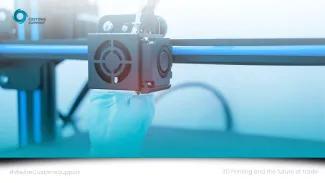Businesses selling plastic goods have been able to leverage this, removing the costs and timelines of importing and instead choosing to print in their office or local workshop. But what are the limits of 3D printing, and how could progression in this industry relate to customs? Find out in this article.
How 3D printing works
3D printing uses a digital file to create a three-dimensional product. How this works is the printer adds small amounts of material in layers through a tube to build the shape, similar to how you would pipe on cake icing to create detail.
The use of 3D printers removes the need to transport goods or store them locally. Additionally, there is less material used in 3D printing compared to using traditional moulds.
Which materials are used?
Plastic is the most common material that is used in 3D printers, with polylactic acid (PLA) being the most popular type due to it being easy to use and less toxic than other alternatives. However, it is not as strong as other plastics, so it is not always suitable.
For components that require more strength, Acrylonitrile butadiene styrene (ABS) is commonly utilised as it is cheap and easy to use. Users of ABS typically require a more ventilated space as the fumes emitted are unpleasant and toxic, which is why PLA is preferred by many smaller businesses.
The list of other materials used in commercial 3D printing is rapidly expanding, with metal, graphite, carbon fibre, medical molecules, and even human skin currently being printed. Researchers are also working on food, with chocolate, bread, and candy already successfully printed.
Development in the 3D printing industry is accelerating as many verticals are beginning to realise its potential. A study by Statistica found that the 3D printing industry is expected to grow by 17% per year between 2020 and 2023, from $12.6b to $20.18b.
As more verticals drive innovation in the 3D printing industry, the list of successfully printed things grows. With human tissue, robots, and even an entire building created by 3D printing, the possibilities are endless. Imagine a world where transplant organs and car components could be created locally, the same day, or where you could print your favourite meal at home with no waste.
How could traders and customs be affected?
With manufacturers losing out on exports and innovators risking copycats stealing their products, what can they do to reduce their loss of revenue? Digital products are intellectual property, and companies do hold patents for digital files, but policing theft around the world is hard to do.
One solution for developers could be encrypted licensing via blockchain technology. Instead of shipping 1,000 pieces of an item, the manufacturer sells a digital licence to print 1,000 of them, with each successful print triggering a reduction of the available quantity against that licence.
This could protect traders from a loss in revenue, but what about customs?
When importing or exporting goods across borders, you need to process a customs clearance. This is when your taxes (if applicable) will be paid. However, when you buy a digital product, the only taxes paid are those on the supplier’s invoice. This does not consider the import duty and VAT that you would have to pay if the product were physical.
Furthermore, tax revenue from additional services such as ocean freight will be lost. With large reductions in import tax, could customs authorities demand that digital products are classified and declared for personal or commercial use? With the licencing example above, this would be a viable method for determining how much value an item should have, and what the tax would be.
With the growth of digital supply chains, customs authorities are sure to develop systems to monitor trading activities and process tax accordingly.
Customs Support are leading developers of digital declarations
As the industry is driving towards digital innovation, so are we. Customs Support provides end-to-end digital clearances throughout the EU and UK, leveraging the internet of things and single trade windows to minimise manual entry, reduce the risk of error, and keep you compliant.
If you could benefit from an agent who is at the forefront of customs technology, can help you prepare for EU centralised clearances, and can assist you with getting AEO certified, then contact us for more information.














